You come to Madrid and you are fascinated with the city, but you want to go one step further. What better way to get to know a place well than to try the local food? From Marli House, we show you the ones you must definitely try to feel like a true Madrileño.
Tapas
In almost any bar in Madrid, they serve you free tapas just by ordering something to drink, but there are places that turn them into an art form. They say that tapas were introduced in the inns and taverns of the 12th century to prevent drunkenness. Tapas are small portions of food that come in all kinds of flavors: croquettes, ham, omelette, bravas potatoes, broken eggs, and many more. It all depends on the creativity of the place. It is very common for the tapas to change as you order more drinks. In Madrid, the most renowned tapas place is Sidrería El Tigre (Calle de infantas, 23), but there are other bars like La Abadía (Calle de Jacometrezo, 15), Los Angeles (Calle del Angel, 8), Preciados (Calle Preciados, 38), or the tavern of Angel Sierra (Gravina, 11). The list could go on, but these are some in the city center.
Cocido madrileño
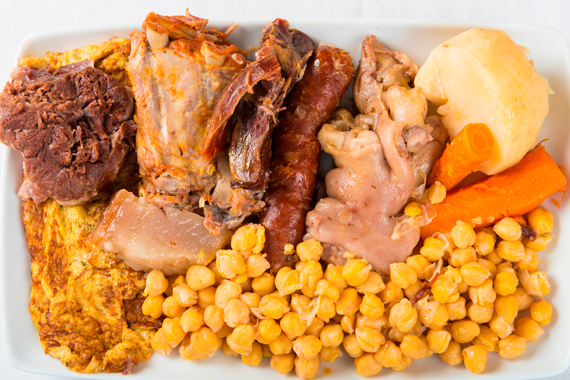
The cold winter of Madrid invites you to eat hot meals, and cocido madrileño is one of the best options. It is a stew whose main ingredient is chickpeas accompanied by various vegetables, meats, and pork fat. It is a very calorie-rich meal to face the low temperatures. We suggest some places where you can taste it: Casa Lhardy (Carrera de S. Jerónimo, 8), Malacatín (Calle de la Ruda, 5), Taberna de la Daniela (Calle Cuchilleros, 9), Los Galayos (Calle Botoneras, 5), or La Clave (Calle Velázquez, 22).
Callos madrileños
Callos are nothing more than the tripe of pork or beef, and in Madrid, they are a gastronomic specialty. In the case of the Madrid specialty, beef tripe is used and combined with Asturian chorizo, blood sausage, bacon, tomato sauce, chili pepper, and other spices. Everything is boiled, resulting in a special dish for winter. The recommended list to try them is as follows: La Tasquería (Calle del Duque de Sesto, 48), Zalacaín (Calle Álvarez de Baena, 4), Viavelez (Avenida del General Perón, 10), Latasia Casa de Comidas (Paseo de la Castellana, 115), or La Tasquita de Enfrente (Ballesta, 6).
Calamari Sandwiches
Calamari sandwiches are slightly cheaper than some of the dishes we have presented in this list, but that doesn’t mean they are any less delicious. They are simply battered and fried squid rings served in a sandwich. It is very common to see tourists eating them while seated in Plaza Mayor, as the traditional places where they are cooked can be found nearby. You can get calamari sandwiches at La Campana (Calle de Botoneras, 6), Bar La Ideal (Calle de Botoneras, 4), Bar Postas (Calle de Postas, 13), Cervecería Restaurante Plaza Mayor (Plaza Mayor, 2), or Bar El Brillante (Plaza del Emperador Carlos V, 8).
Estrellados Eggs
That’s right, they are called “estrellados” or “broken” eggs. They are one of the most popular dishes in Madrid. It is a dish where eggsshare the spotlight with ham and also includes potatoes. Although it is a very simple dish, it is a delight. In Madrid, you can find them at places like Los Rotos (Calle de Huertas, 74), Los Huevos de Lucio (Calle de la Cava Baja, 32), Taberna Almendro (Calle del Almendro, 13), Restaurante Taberna Madrid Madriz (Calle de Fuencarral, 85), or La Casa del Abuelo (Calle de la Victoria, 12).
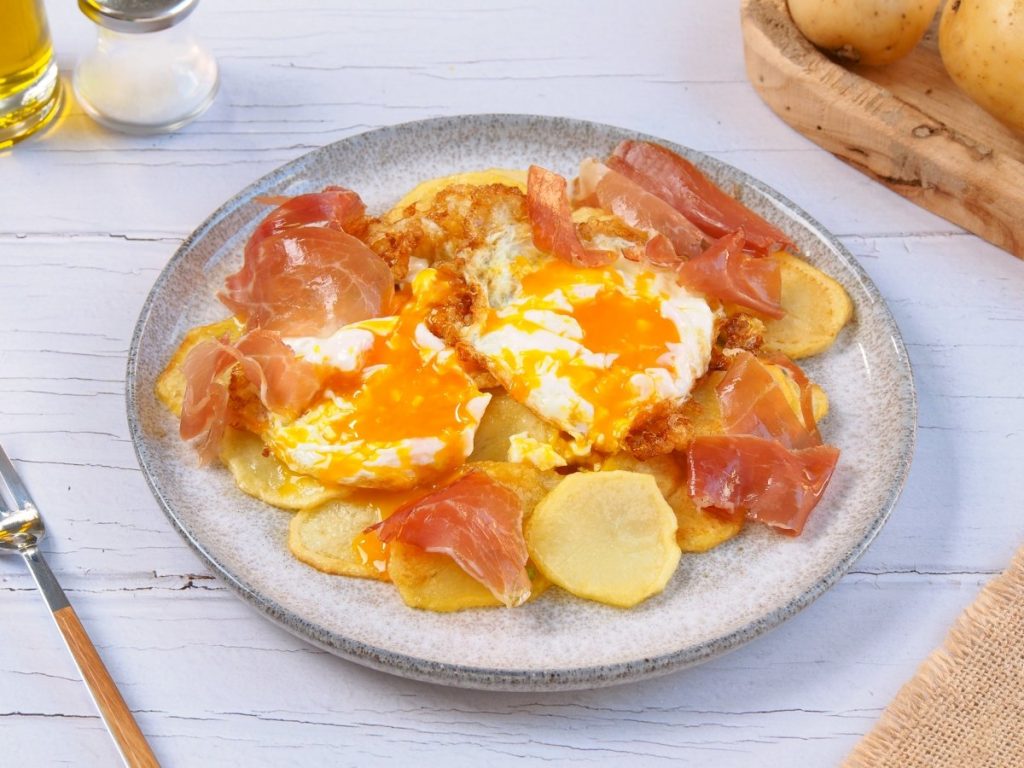
Garlic Soup
Another typical Madrid recipe is garlic soup, which also includes eggs, bread, chicken broth, and paprika. You can order it at Restaurante Al Socaire (Calle de Pío Baroja, 10), Las Cuevas de Luis Candelas (Calle de Cuchilleros, 1), Casa Labra (Calle de Tetuán, 12), Casa Carola (Calle de Padilla, 54), Ajo y sal (Paseo de San Francisco de Sales, 41), or Taberna Casa Maravillas (Calle de Jorge Juan, 54).
Besugo a la madrileña
You know that Madrid is not located on the coast, but that doesn’t mean you can’t enjoy a good sea bream, thanks to the direct supply from Cantabria and Galicia. Sea bream in Madrid has been cooked since the 18th century, and tradition dictates that it should be prepared with onion, garlic, potatoes, parsley, olive oil, lemon, and breadcrumbs. The result is a crispy dish that can be savored with wine. Where can you try it? At Casa Lucio (Cava Baja, 35), Madrid (Calle Bureta, 7), Filandón (Carretera de Fuencarral al Pardo km 1,900), El Pescador (Calle Ortega y Gasset, 75), or O´Pazo (Reina Mercedes, 20).
Potaje de garbanzos
Potaje de garbanzos is one of those dishes that are preferably eaten on a specific date. It includes chickpeas, spinach, cod, and is especially consumed on the Friday of Lent during Holy Week, but that doesn’t mean you can’t order it throughout the year. This dish, dating back to the Middle Ages, was prepared in clay pots with many spices. In Madrid, you can order potaje de garbanzos at places like Restaurante La Clave (Calle de Velázquez, 22), La Gran Tasca (Calle de Santa Engracia, 161), La Rayúa Gran Vía (Calle de la Luna, 3), El Pescador de Monte Carmelo (Avenida del monasterio de Silos, 22), or Restaurante Los Galayos (Calle de Botoneras, 5).
Tortilla de patatas
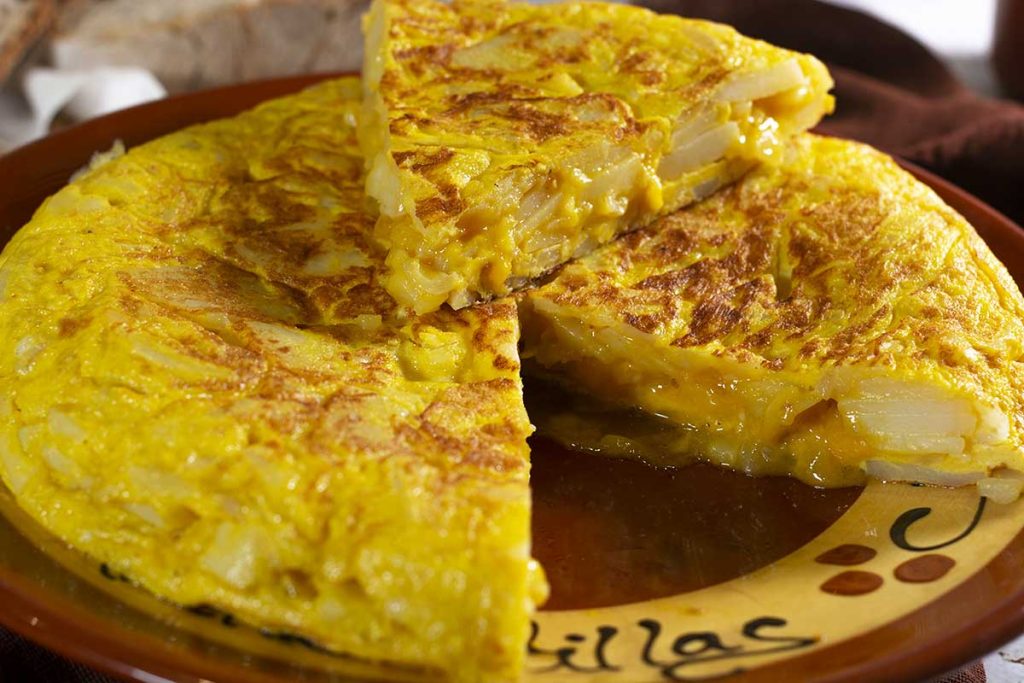 Do you prefer it with or without onions? This is the eternal debate about how a true Spanish omelette should be. The truth is, in Madrid, it is generally eaten with the center slightly runny, meaning the inside is somewhat soft or the eggs are slightly undercooked. It is a very common dish that you can find in almost every bar and restaurant, and you can even buy it at the supermarket. But it’s best to eat it freshly made. We suggest the following places, some specialized in tortilla de patatas: Casa Dani (Calle del Pez, 36), Sylkar (Calle de la Espronceda, 17), Restaurante Las Tortillas de Gabino (Calle de Rafael Calvo, 20), Hoy Tortilla (Calle de Finisterre, 15), or La Tortilla Restaurante (Calle Condesa de Venadito, 26).
Do you prefer it with or without onions? This is the eternal debate about how a true Spanish omelette should be. The truth is, in Madrid, it is generally eaten with the center slightly runny, meaning the inside is somewhat soft or the eggs are slightly undercooked. It is a very common dish that you can find in almost every bar and restaurant, and you can even buy it at the supermarket. But it’s best to eat it freshly made. We suggest the following places, some specialized in tortilla de patatas: Casa Dani (Calle del Pez, 36), Sylkar (Calle de la Espronceda, 17), Restaurante Las Tortillas de Gabino (Calle de Rafael Calvo, 20), Hoy Tortilla (Calle de Finisterre, 15), or La Tortilla Restaurante (Calle Condesa de Venadito, 26).
Jamón Sandwich
Surely you have seen them displayed in the windows like towers of sandwiches. In Madrid, there is an abundance of ham sandwiches, just like in the rest of Spain. However, this simple dish has its specialists in Madrid, as choosing good bread and, above all, good ham is crucial. We suggest some places where they have mastered this type of food: El Museo del Jamón (Calle Mayor, 7, and other branches), Bocadillos Oink (Calle Gran Vía, 22), Viandas Hacienda Zorita (Calle de la Montera, 3), Bar El Brillante (Plaza del Emperador Carlos V, 8), and Los Bocadillos (Calle del Marqués de Urquijo, 1).
Madrid-Style Snails
You read that right: in Madrid, they eat snails with their own style. You may not be a fan of this type of dish, but if you are, keep reading. While in other parts of Spain, snails are cooked with butter and parsley, grilled, with mint, or with rice, in Madrid, they are cooked with meat broth, seasoned with serrano ham, chistorra (a type of sausage), and a sofrito of vegetables and chili pepper. It’s a truly exquisite combination that you shouldn’t miss. It is a typical dish in June, and you can try it at places like Bar Los Caracoles (Calle de Toledo, 106), La Cocina de María Luisa (Calle Jorge Juan, 42), La Malaje (Calle Relatores, 20), Casa Amadeo Caracoles (Plaza de Cascorro), or Mercado de Vallehermoso, which is well-known for preparing this type of dish. Are you up for trying them?
Entresijos and Gallinejas
Gallinejas are fried lamb intestines, a dish almost exclusive to Madrid, sold in specialized shops (especially fry shops), but in the past, they were obtained from kiosks or popular stores. The “entresijo” also comes from the gallineja. They are not as easily found nowadays, but we will show you some places where they usually make them: Casa Enriqueta (Calle del General Ricardos, 19), Freiduría Gallinejas (Calle de Ramírez Tomé, 32), Freiduría El Chaval (Calle de la Esfinge, 76B), Casa Ricardo (Calle de Fernando El Católico, 31), or Freiduría Nucita (Avenida Pablo Neruda, 81).
Patatas Bravas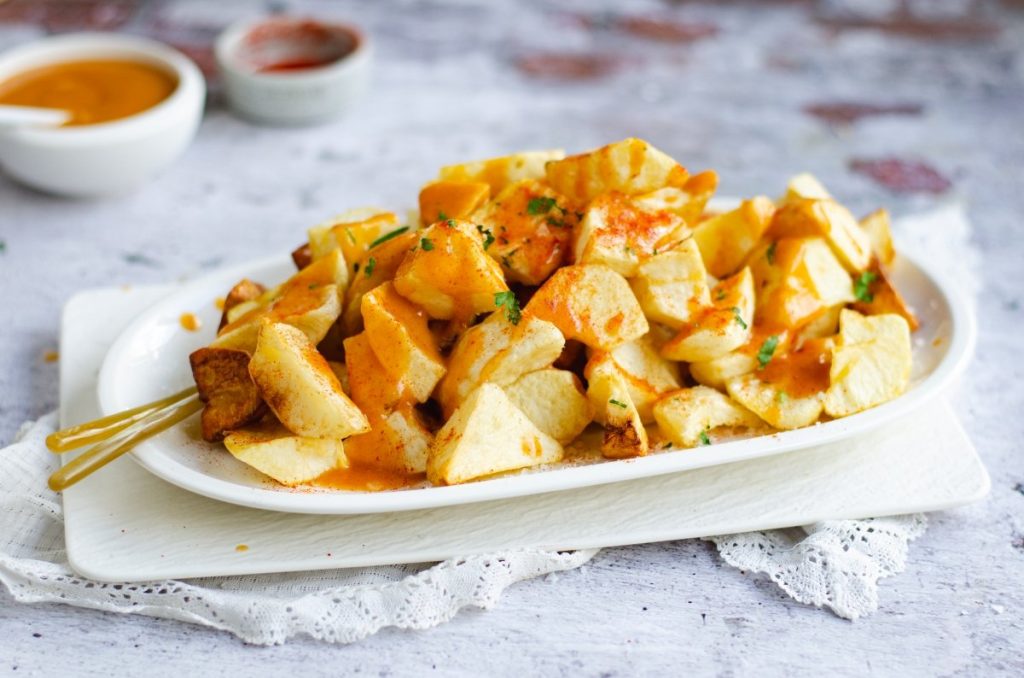
Patatas Bravas are often served as tapas, as they are offered in some places to accompany drinks. However, they can also be ordered as a standalone dish. They consist of potatoes cut into wedges, fried in oil, and topped with a sauce made with garlic, flour, sweet paprika, spicy paprika, and vegetable or chicken broth. The sauce can be slightly spicy, hence the name “bravas.” This typical Spanish combination, so simple yet delicious, can be found at places like Las Bravas (Pasaje de Mathéu, 5 and Calle de Alvarez Gato, 3), Los Chicos Fábrica de Patatas Bravas (Calle de Guzmán el Bueno, 33), Bar Cervecería Las Bravas (Calle de Meléndez Valdés, 62), Docamar (Calle de Alcalá, 337), or Bodega de la Ardosa (Calle de Santa Engracia, 70).
Pork Ear and Snout
When it comes to food, in Spain, everything is used. That’s why pork ears and snouts are no exception. In Madrid, you can enjoy them stewed in sauce or grilled, especially in bars.
You can order them at La Oreja de Jaime 2 (Calle de la Cruz, 15), Casa Toni (Calle de la Cruz, 14), Bar Gonmar (Pasaje de Marcelino Camacho, 47), La Casa de los Minutejos (Calle de Antonio de Leyva, 19), or Kult0 (Calle de Ibiza, 4) in Madrid.
Banderillas
Banderillas are pickled foods skewered on a long toothpick and served in many bars in Madrid. They are a type of brochette with a spicy flavor from chili peppers and a tangy taste from the pickled ingredients. They are usually served alongside drinks like beer.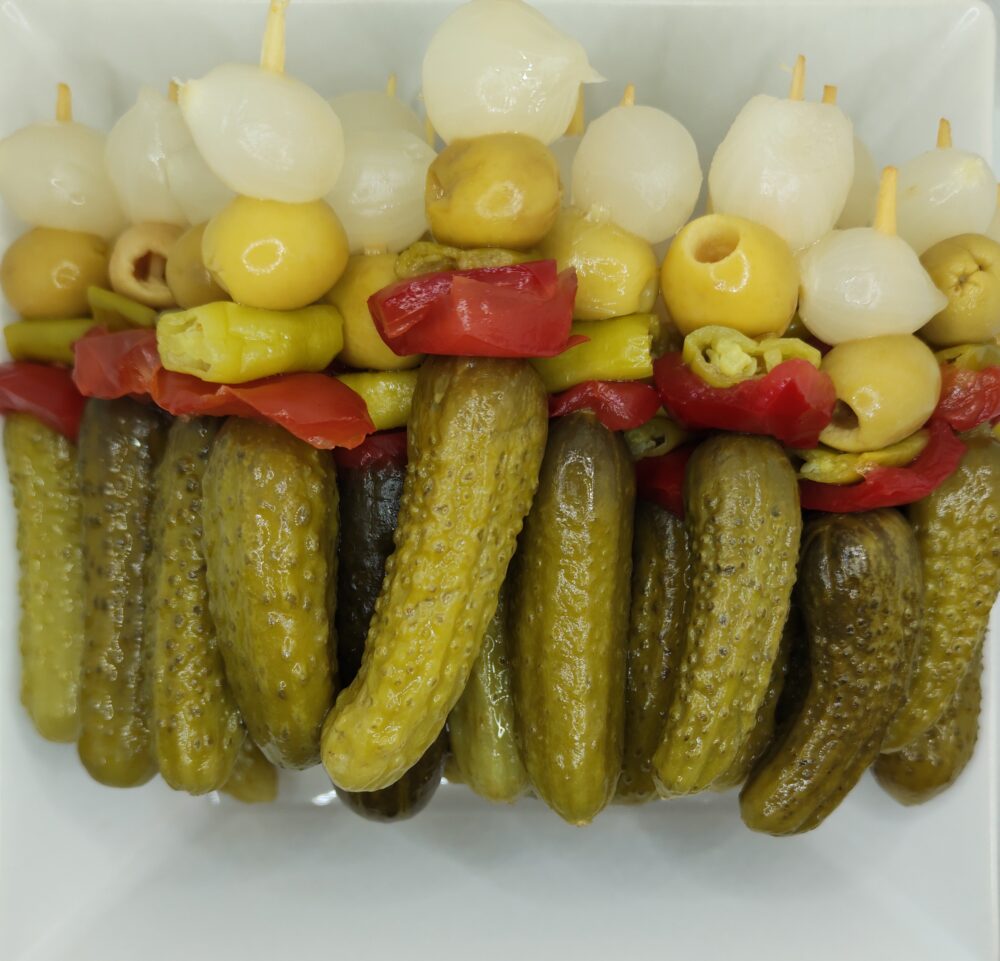
You can find them at Paradis Madrid (Calle del Marqués de Cubas, 14), La Sanabresa (Calle del Amor de Dios, 12), Los Chuchis (Calle del Amparo, 82), La Bistroteca (Calle de Espartinas, 7), or La Tasquería (Calle del Duque del Sesto, 48) in Madrid.
San Isidro Donuts
San Isidro donuts are traditionally eaten between May 1st and the end of the San Isidro Labrador Festivities. They are part of traditional Madrid pastries and are divided into sugar-coated ones (rosquillas listas), plain ones (rosquillas tontas), Santa Clara-style (covered with meringue), or French-style (coated with almonds).
Here are some places where you can buy them: El Horno de San Onofre (Calle de San Onofre, 3), Pastelería La Mallorquina (Puerta del Sol, 8), Casa Mif (Carrera de San Jerónimo, 30), La Duquesita Confitería y Repostería (Calle de Fernando VI, 2), or El Riojano (Calle Mayor, 10).
Bartolillos
Bartolillos are sweets eaten during Holy Week and are typical of Madrid’s pastry. They have a triangular shape, are fried, and filled with custard cream. They are a delicious combination typical of Holy Week.
The good news is that you don’t have to wait for those dates to try them, as you can find them in different places in the city: El Riojano (Calle Mayor, 10), Antigua Pastelería del Pozo (Calle del Poco, 8), La Duquesita Confitería y Repostería (Calle de Fernando VI, 2), Horno La Santiaguesa (Calle Mayor, 73), or Pastelería La Mallorquina (Puerta del Sol, 8) are some of the places near Marli House apartments.
Churros with Chocolate
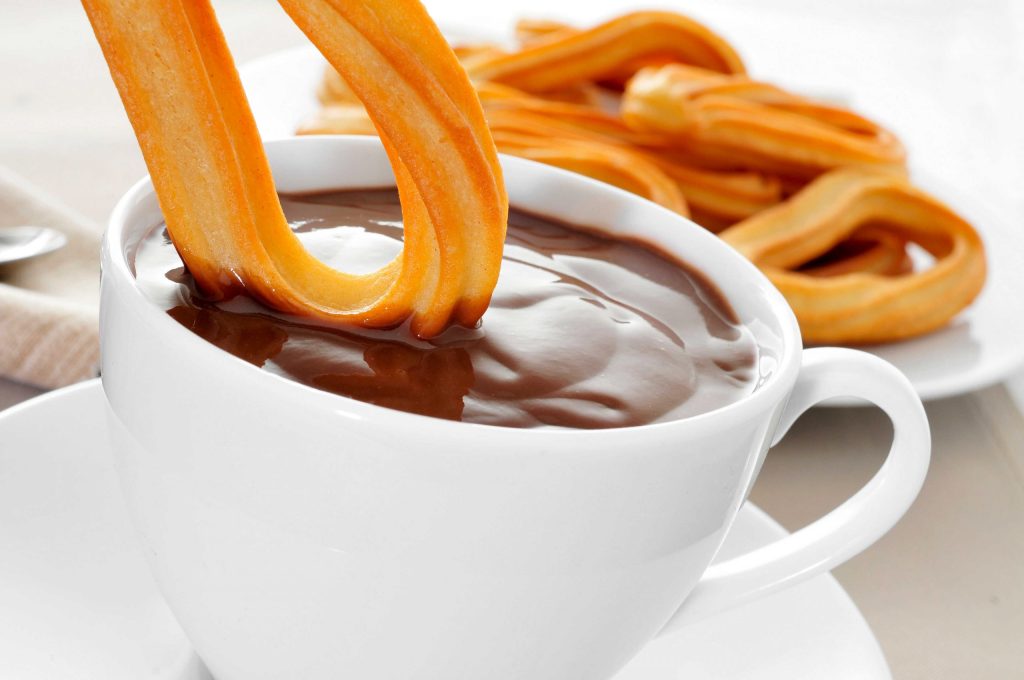 The winter star in Madrid is churros with chocolate. It consists of a fried dough made from flour and is popular in Spain, as well as in Latin America, Portugal, France, the Philippines, Belgium, and parts of the United States. The ideal combination for churros is a good cup of thick and hot chocolate.
The winter star in Madrid is churros with chocolate. It consists of a fried dough made from flour and is popular in Spain, as well as in Latin America, Portugal, France, the Philippines, Belgium, and parts of the United States. The ideal combination for churros is a good cup of thick and hot chocolate.
In Madrid, it is common to find churro shops, but from Marli House, we’ll show you some: Chocolatería San Ginés (Pasadizo de San Ginés, 5, perhaps the most popular of all), Chocolatería de de la Puerta Del Sol (Calle del Correo, 4), Chocolate y Churros (Calle Mayor 54), Chocolat Madrid (Calle de Santa María, 30), and chocolatería 1902 (Calle de San Martín, 7).
Torrijas
You’ve probably heard of torrijas or French toasts. They are a sweet treat made with a slice of stale bread soaked in milk, syrup, or wine, dipped in egg, and fried in oil. They are then sweetened with honey, molasses, or sugar and flavored with cinnamon.
Now that you know the ingredients, you’ll surely want to try them. Although they are a typical Easter sweet in Spain, you can try them at different bakeries near Marli House. Here are some: La Casa de las Torrijas (Calle de la Paz, 4), Pastelería Torrijas (Calle del Pozo 8), El Riojano (Calle Mayor, 10), Nuevo Horno de Santa Teresa (Calle de Santa Teresa, 8), and Hontanares (Calle de Sevilla, 6).
We hope this list helps you explore Madrid through its flavors and aromas. Let us know which food you liked the most. Enjoy!
